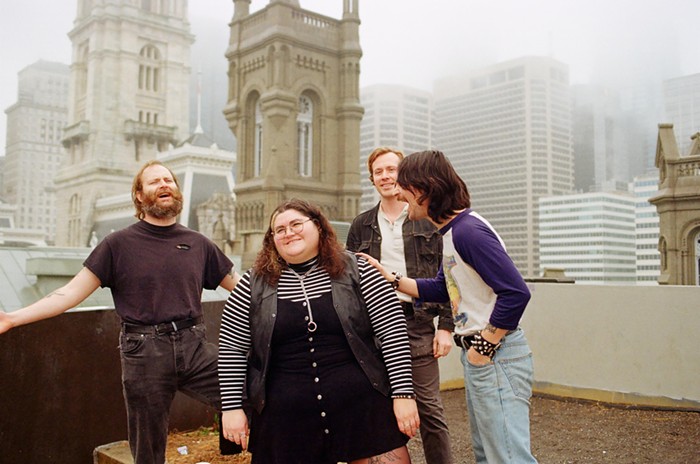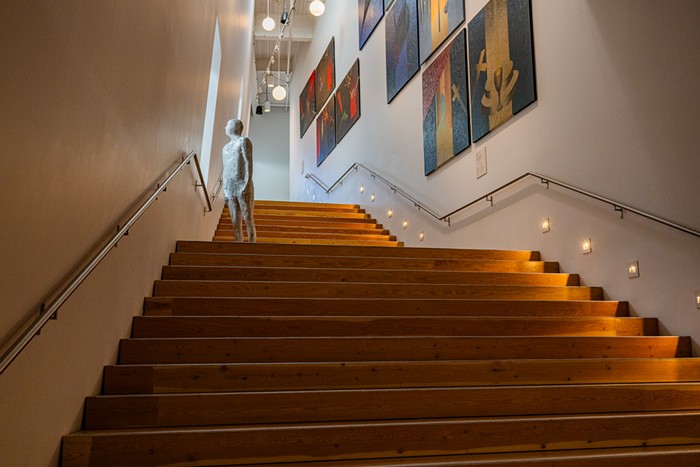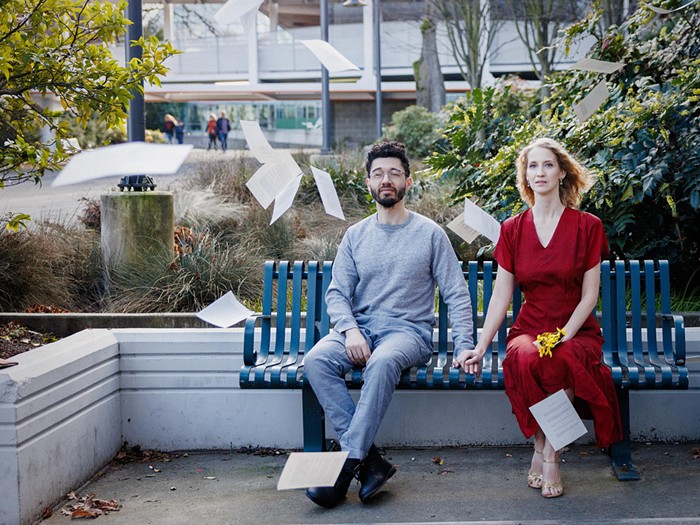
Like most interesting things in this day and age, I discovered artist Joey Veltkamp while scrolling through Facebook.
After a few guided clicks, I learned that Veltkamp is an openly gay artist based in Bremerton (he recently moved there after living in Seattle for 20 years) known for incorporating protest-themed messaging and imagery in his works, which have been featured at Seattle Art Museum, SOIL Gallery, other well-known spaces for the arts in the Northwest—and now, Facebook. I looked through his website’s fabric works gallery, and was getting cozier by the minute.
These pieces run the gamut from the charmingly cheeky Heyyy Sailor and Yoohoo, to the blunt WE’RE ALL GONNA DIE (as presented on a giant pink quilt), and Jesus Christ Made Seattle Under Protest, one of several works that features Seattle history and know-how.
Geekwire's recent tour of Facebook’s Westlake location in Seattle explores features of the building, including a plethora of site-specific murals, sculptures, mixed media, paintings, and installations from selected local artists—like Veltkamp—through Facebook's Artist-In-Residence initiative.
I hastily decided that I needed to take this URL moment off-line into the IRL world—it was time to check-in to Facebook with Veltkamp for an interview.
Several days later, I got my face approved by the electronic eyeball on Facebook’s glass doors at their Westlake location, checked myself in via the front desk iPad, and walked over to greet Veltkamp. He was cheerfully chatting away with the guide who would accompany us during our time in the Facebook offices. For as much Facebook knows about us (and how they have used that information), they are firm, but pleasant, about making sure we don’t end up Facebook-stalking Facebook while inside of Facebook. My brain initially short-circuited with that thought, but quickly shifted gears as we did made our way to the third floor, where Veltkamp’s works are on display.
Our conversation trickled to a crawl as we examined Veltkamp’s first piece, Don’t Give Up (named after the Peter Gabriel song featuring Kate Bush), and the atmosphere went through a subtle change as it became clear that Veltkamp was ready to begin unraveling the stories behind his stitches.

DON’T GIVE UP
The first story of Don't Give Up is of motherly love gone awry: “When I was a kid, I was watching TV on the floor with my mom,” he said, “and she goes, ‘Hey honey, look at your hands,’ and I remember immediately going like this [Veltkamp faces me and puts his hand forward, palm-down, fingernails-up, and flexes his fingers], and her just saying, ‘mhmm, I thought so.’” The young Veltkamp silently wondered to himself about just what exactly was going on until he glanced at her copy of the Inquirer, which had diagrams on how men looked at their hands one way, and women another.
Veltkamp had looked at his hand the way a woman would.
For Veltkamp, this was the beginning of years spent trying to hold in his identity, to control his body so that he would not be read as gay—but a body is a body. Veltkamp couldn’t afford to give up or give in to who he was, but that meant that he needed to hide his true self long enough to survive. One such effort was practicing his smile in the mirror for hours on end, which he perfected to his liking. However, years later, when he saw his daughter’s “goofy smile” (Veltkamp is a donor father), he knew it was his, but it was... different. That's when he realized his daughter's smile was the one he once had, before the fear of having his teeth punched out for being gay spurred him to alter it.
Music was one of the few places where Veltkamp could hear what he needed, and he connected with the chorus of Peter Gabriel’s “Don’t Give Up,” as sung by Kate Bush. “So maybe I probably didn’t have a mom who was super clued-in—I’m sure I was a complicated kid—on how to maybe support this [being gay],” said Veltkamp. “I think as a parent, it’s like you’re pruning a tree. You want to give it some shape, but it can’t go wild, and you’re scared of cutting off the core part or the right part, you know? And I think I probably required some special care.” Veltkamp continued that Kate Bush’s vocals on “Don’t Give Up” were “the mother voice I needed.”

WHAT A TIME TO BE ALIVE
We rounded the corner in the Facebook offices to look at the other piece, and both of us absolutely lost it when we come face to face with a gargantuan Pusheen collectible plush that could easily double as a small couch.
After the laughter faded, Veltkamp shared the tale behind this piece. At 40 years old, Veltkamp had a “well-timed mid-life crisis,” and soon after went into a DBT (Dialectical Behavior Therapy) program. Following the year-long course, Veltkamp came out feeling—for the first time in his life—happy to be alive.
That experience, and Veltkamp’s newfound lease on life, fed into the initial conception of What a Time to Be Alive. However, there is more than meets the eye when it comes to Veltkamp’s works.
“We now have the curtains ripped off everything, we’ve realized the world is even worse than we thought,” he said. “We have all this access and resources and we can look back and pat ourselves on the back… but trans women [are] getting murdered constantly, we are not taking care of homeless people, black people, people of color, anyone.”
Veltkamp emphasized that these are long-lasting effects of institutional neglect and erasure, which the generation of LGBT activists before him had faced, lived through, and confronted. However, he acknowledged, things are different now. The vibrant colors of Veltkamp’s work capture the dissonance of a progressing society, but one that is doing so on the backs and suffering of the marginalized.
My throat began to feel as dry as the quilt. It was—and is—a lot to process.
“It [What A Time To Be Alive] is deceptively bright and happy,” Veltkamp explained, “and if you’re just walking by you can read it like, ‘Oh wow, what a time to be alive,’ but if you spend more time with it you’ll eventually be like, ‘Ugh, weird, what a time to be alive’ and that’s where I think that piece lives.”
Veltkamp recently held a solo exhibition at Greg Kucera Gallery, where select works are still on display, and you'll also find some pieces by him in the Bellevue Arts Museum lobby. Veltkamp will be exhibiting with Outer Space in a show tentatively dubbed Light of the World/Salt of the Earth; it begins August 29 (location TBD).


















